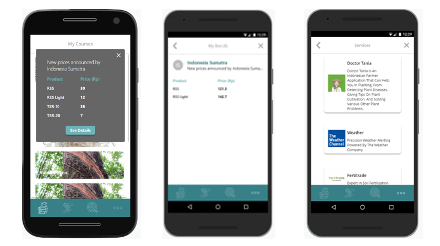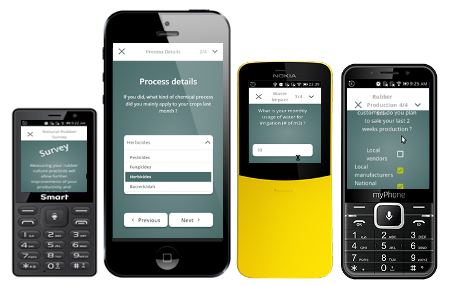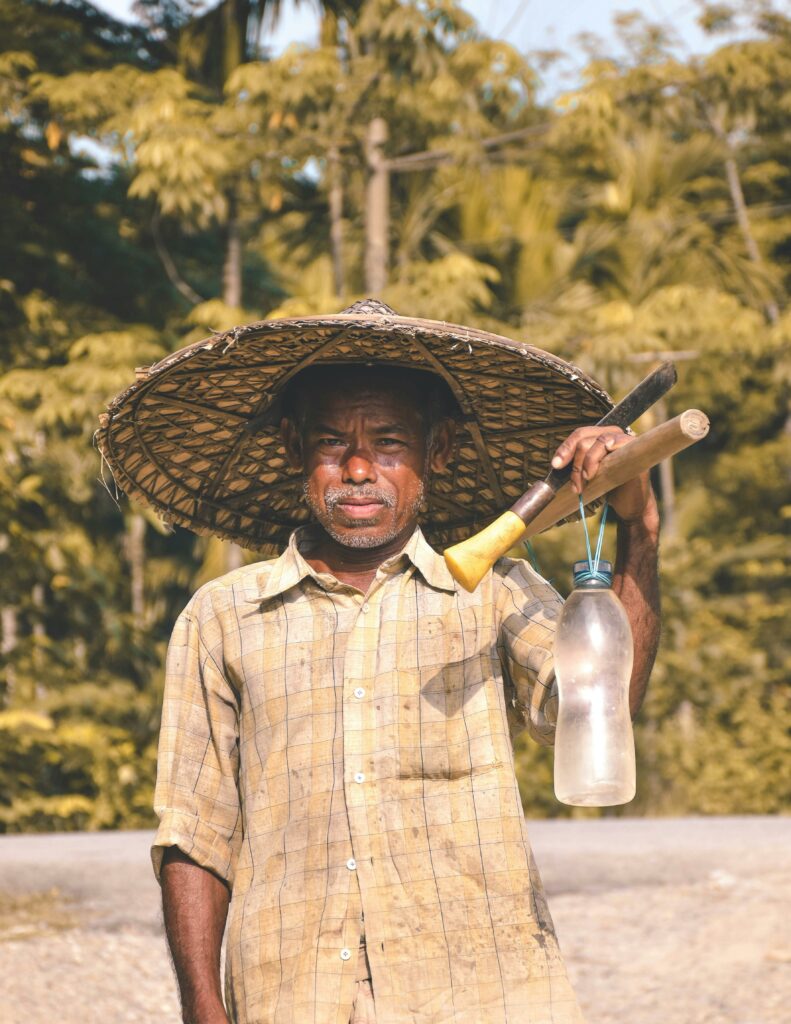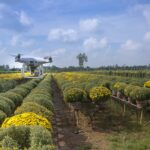500 million smallholders in the world represent the very first mile of most agricultural commodities. Generally low educated and navigating close or below poverty line, these farmers are struggling while they bear most of the environmental and social responsibilities of their value chains: safety, carbon sequestration, human right issues, biodiversity or water preservation. All these issues of growing importance for regulators and corporations downstream can primarily solved only when engaging and closely working with these critical stakeholders. In this regard, using digital tools holds the key to ensure programs can be scaled up in a cost-effective manner. Ksapa has unique expertise in the space and hereby shares some tips to ensure successful adoption of digital tools through its own programs deploying its SUTTI App Digital suite with smallholders across multiple emerging markets.
What are the top 3 challenges for smallholder farmers to use digital tools?
Smallholder farmers face several challenges when adopting digital tools, particularly in rural and resource-constrained environments. The top three challenges are hereby provided:
1. Limited Access to Technology and Infrastructure
Many smallholder farmers lack access to essential infrastructure such as reliable internet, electricity, and smartphones. In rural areas, internet connectivity is often weak or unavailable, and the cost of devices like smartphones, tablets, or even basic mobile phones can be prohibitive. This digital divide prevents farmers from accessing tools that could improve their productivity or market opportunities.
2. Digital Literacy and Skills
Many smallholder farmers have low levels of digital literacy. Even if they have access to the necessary technology, they may lack the skills to use digital platforms, apps, or online services effectively. Training on how to use digital tools, interpret data, and apply digital resources in farming practices is often scarce, making adoption slow and difficult.
3. Cost and Affordability of Services
The costs associated with using digital tools, whether for mobile data, purchasing devices, or subscribing to agricultural services, are often too high for smallholder farmers with limited financial resources. Additionally, even when digital solutions are available, there might be a lack of locally relevant and affordable services, which deters smallholders from seeing the value in adopting them.
These challenges combine to slow the uptake of digital tools among smallholder farmers, limiting the potential benefits such tools could offer in terms of improving yields, accessing markets, or managing climate risks.
What are the top 3 best practices to ensure effective adoption of digital tools for smallholder farmers?
To ensure effective adoption of digital tools by smallholder farmers, it is essential to address their unique challenges and needs. Here are three best practices for successful adoption:
1. Tailor Solutions to Local Context and Needs
Digital tools should be designed with a deep understanding of local farming practices, cultural norms, and the specific challenges faced by smallholder farmers. This means:
- Localized content: Provide information in local languages, and ensure the content is culturally relevant and easy to understand.
- Contextualized features: Tools should focus on addressing farmers’ immediate needs, such as weather updates, pest management, and local market prices.
- Offline capabilities: Since internet access is often unreliable, designing apps or tools that work offline can greatly increase usability.
2. Provide Ongoing Training and Capacity Building
Many smallholder farmers have low digital literacy, so continuous training and support are crucial for long-term adoption:
- Farmer training programs: Organize workshops, field demonstrations, and peer-learning opportunities to teach farmers how to use digital tools effectively.
- Extension services: Leverage agricultural extension workers or local organizations to offer hands-on assistance and serve as intermediaries between farmers and technology.
- User-friendly interfaces: Ensure that digital tools have simple, intuitive interfaces that are easy for farmers to learn and use, even with minimal literacy or technical skills.
3. Ensure Affordability and Accessibility
Making digital tools affordable and accessible is critical for widespread adoption:
- Subsidized access: Governments, NGOs, or private sector partners can provide subsidies or financial assistance to help farmers access digital tools and services.
- Partnerships with telecom companies: Work with mobile network operators to offer affordable data plans or mobile-based solutions (e.g., SMS-based services) that reduce costs for farmers.
- Freemium models: Provide basic services for free, with optional premium features. This allows farmers to see immediate benefits without upfront costs.
By addressing the specific needs of smallholder farmers through localized solutions, training, and affordability, digital tools can become more accessible and impactful in rural farming communities.
How does the SUTTI Digital App can help scale capacity building programs through adoption of a digital companion?
The SUTTI Digital Suite, developed by KSAPA, has been specifically designed to meet the needs and constraints of smallholding farmers and other vulnerable populations alike.
Through its simple, localized and accessible Participant App, smallholders can gain access to digitalized versions of the training courses that KSAPA local partners deliver face-to-face as part of SUTTI capacity building programs. This allows smallholders to reinforce their learning as they return to their farms after the in-person training. Smallholders can also get peer and instructor support via an integrated messaging system should they encounter issues when applying the good agricultural practices and other learnings they got taught.

In addition, the App provides them with Market Access and connects them with tailored third-party services that are valuable for their work and life activities – selected intrant dealers, financial services, local events and weather alerts to name a few.

Lastly, smallholders can also use the App to assess the benefits of the SUTTI Capacity Building on their work and life conditions, by regularly keying data that will allow monitoring the evolution in crop yields, productivity, health and safety and environmental footprint over time. Indeed, smallholders can routinely fill Impact measurement surveys which feedback not only encourages them to adopt new tools

What makes the SUTTI Participant App successful in that endeavor?
The SUTTI Participant App has been primarily designed to be as contextualized and inclusive as possible with respect to its targeted users.
- The SUTTI App as a deliberately simple and accessible user interface. The navigation inside the app uses recognizable icons and simple language so that the user can navigate easily without confusion. The App features integrated guides and tutorials to guide users through their first use. Its interface is compatible with assistive technologies such as screen readers or other assistive devices for people with reading disabilities. Yet, as it turns out that many smallholders don’t know how to use screen readers on their devices, the SUTTI App also includes built-in text-to-speech feature that is simple to use, so as not to exclude Digitally-unsavvy user. We’ve also made it possible to zoom in the user interface should the text or icons look too small for users to read. These functions can look trivial, but many mobile learning apps in the market lack these basic functionalities which are key for smallholders’ adoption.
- The SUTTI App is compatible with the rural terrains where telecommunications network coverage is not always a reality. It is offline mode compatible and automatically retrieves the training contents locally on the device for offline use, which is crucial in rural areas where Internet access is intermittent and for smallholders for which Internet access cost may be prohibitive. Impact measurement surveys can also be filled while offline; as soon as the network connectivity is restored, the App automatically re-synchronizes with the servers to send the data out.
- The SUTTI App runs on all sorts of mobile devices, not only Android and iOS-based smartphones but also KaiOS-based feature phones (increasingly popular in emerging markets), as well as tablets, mini-PCs and more – provided they embed a capable Internet Browser and sufficient storage space to store the App’s training contents. The Participant App is backwards-compatible with old devices models, and still proudly supports (at the time of writing this article, i.e in late 2024) antique devices running on Android 5, iOS 11 and KaiOS 2.0 – all the way up the latest and greatest versions of the latter. This ensures it works with the gear that smallholders have and does not force them to upgrade their hardware or software. As a result, the penetration of the SUTTI Digital tool in the SUTTI Programs around the world is high, as the tool has been purposely designed to lower the technical system requirements preventing smallholders’ adoption.
- The App supports multiple languages and can easily be extended to accommodate languages spoken by smallholders, including local dialects. This way, a training initiative can meet smallholders in their own language. The App also supports browsers’ content translation tools (such as Google and Firefox translation APIs), should a user prefer to use the App in another language that was not originally targeted by the Training Program. This way, the App leaves no-one behind despite language barriers.
- The App training materials are multimedia rich and adapted to the smallholders’ local contexts, ensuring that the application’s information and visuals respect the cultural and social norms of the target users. The included videos, infographics and educational articles are conducive to learning for smallholders. Farmers can also provide feedback to further improve the training material.
- Signing in the App is seamless. Smallholders receive a simple access link by SMS as they enter the Program. Therefore, there’ no need for them to have an email account to join the training, nor even set a password as they first log in. Their secure access token is then kept on their device so their future use of the App comes with no hassle. Should they run into issues when connecting, a live chat or hotline with the Program local staff allows them to get help quickly.
- The SUTTI App ensures smallholders’ Data confidentiality and Privacy: It assure users that their data is protected, gives them control over their personal information and provides a clear explanation as of how the data collected will be used and to what extent Impact Measurement will be performed and shared with Program Stakeholders. This fosters confidence and trust that is key for sustaining the use of the App in the long run.
Conclusions
Potential using digital app for farmers is huge and can ensure benefits the like: access to technical knowledge, insight, peer to peer learning, data collection for impact monitoring. 500 million smallholders in the world lack access to such infrastructures. Ksapa has developed a unique expertise in the space engaging and working with such smallholders. Contact us and adopt our solutions to engage smallholders in programs improving value chains social and environmental performance, food security and sequestration of carbon across agricultural environments.


















